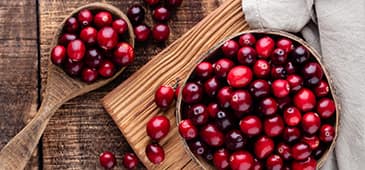
What's Hot
What's Hot
News flashes are posted here frequently to keep you up-to-date with the latest advances in health and longevity. We have an unparalleled track record of breaking stories about life extension advances.
- Meta-analysis concludes benefit for cranberry against UTI
- Meta-analysis finds reduced heart failure mortality in association with CoQ10
- More on flavonoids
- Delicious high flavonoid foods associated with lower dementia risk
- Coffee, caffeine linked with protection against multiple diseases
- Umbrella review adds evidence to magnesium blood pressure benefit
- Review reveals multiple benefits of citicoline
- Higher vitamin E intake linked with lower mortality risk in COPD patients
- Astragalus lengthens telomeres in human study
- Nicotinamide riboside increases brain NAD+
- Niacin associated with lower markers of inflammation
Meta-analysis concludes benefit for cranberry against UTI
September 30 2024. A systematic review and network meta-analysis of randomized, controlled trials published July 18, 2024, in European Urology Focus concluded that evidence supports the use of cranberry or increased intake of liquids for the prevention of urinary tract infection (UTI).
Authors Christian Moro of Bond University in Australia and colleagues remarked that studies investigating the effects of cranberry against UTI have had varied results and it was not known whether the benefit of cranberry was due to the fruit itself or an associated increase in liquid intake (which is recommended to help prevent UTI).
The research team identified 20 trials that included a total of 3,091 participants for their review. Trials compared the effects of cranberry juice or tablets with a liquid placebo or other liquid, standard management or no treatment in women and men at risk of UTI. Duration of treatment ranged from two weeks to a year and participants were followed from two to 12 months.
Meta-analysis of 18 trials found a 54% lower risk of UTI among participants given cranberry juice in comparison with no treatment and a 27% lower risk compared with a placebo liquid. In an analysis of the six studies that included assessment of antibiotic use for UTI, participants who used cranberry juice had a 49% lower rate of needing antibiotics compared with a placebo liquid and a 59% lower rate compared with no treatment. Meta-analysis of the three studies that reported urinary symptoms found significant favorable effects for cranberry.
"With the increasing prevalence of antimicrobial-resistant UTIs, alternate non-drug treatment options for its management are required," the authors noted. "Available evidence supports the use of cranberry compounds and increases in fluid intake for managing UTIs."
—D Dye
Meta-analysis finds reduced heart failure mortality in association with CoQ10
September 25 2024. A systematic review and meta-analysis of clinical trials published June 6, 2024, in Future Cardiology found improved survival and greater exercise capacity among people with heart failure who received coenzyme Q10 (CoQ10) compared with a placebo.
In the current research, Shurjeel Uddin Qazi of Dow University of Health Sciences and colleagues identified 16 randomized, controlled trials that compared the effects of CoQ10 to a placebo. Participants in the studies had New York Heart Association functional class II-IV heart failure and were clinically stable for three months prior to the studies.
In pooled analyses, participants who received CoQ10 had a lower risk of premature mortality and improved exercise capacity compared with a placebo. Among the eight trials that evaluated mortality, there were 65 deaths among a total of 1,049 participants who received CoQ10 and 116 deaths among 1,087 participants who received a placebo, resulting in a 40% lower risk of premature mortality among people who received CoQ10. When the five trials that evaluated exercise capacity were analyzed, individuals who received CoQ10 were also improved compared with a placebo.
No effect for CoQ10 was found on left ventricular ejection fraction (LVEF), a measure of the percentage of blood the left ventricle pumps from the heart during each contraction, which is below normal in approximately half of heart failure patients.
In their discussion of the findings, Qazi and colleagues remarked that CoQ10 "has emerged as a new frontier in the study of heart failure, offering promising applications in improving metabolic processes, repairing damaged cells and boosting the immune system. Acting as a potent antioxidant, CoQ10 reduces harmful free radicals in the body"
They concluded that CoQ10 "may be a useful complement to the therapy of heart failure, providing improved exercise capacity and mortality outcomes."
—D Dye
More on flavonoids
September 23 2024. A study published in the American Heart Association journal Arteriosclerosis, Thrombosis and Vascular Biology revealed an association between greater intake of flavonoids and a reduction in the risk of subclinical atherosclerosis (undetected cardiovascular disease). Flavonoids are plant compounds that have been associated with a lower risk of disease.
The investigation included 5,599 participants in the Multi-Ethnic Study of Atherosclerosis. Flavonoid intake and subclinical atherosclerosis were assessed at two examinations conducted during 2000-2002 and 2010-2011. The presence of subclinical atherosclerosis was evaluated by measuring ankle-brachial index (the ratio of blood pressure at the ankle to blood pressure in the upper arm which, when low, indicates arterial blockage), coronary artery calcification and carotid artery plaques and thickness of the intima-media (the innermost layers of the artery wall).
After averaging the measurements obtained at both examinations, individuals whose intake of flavonoids was among the top 25% of participants had a 26% lower risk of having an unfavorable ankle-brachial index of less than 1 and an 18% lower risk of carotid plaque than people whose flavonoid intake was among the lowest 25%. Having an intake of the flavonoids known as flavonols, flavanol monomers and anthocyanins that was among the top 50% of participants was associated with a 19%-34% lower risk of an unfavorable ankle-brachial index and 18%-20% lower carotid artery plaque risk. Consumption of anthocyanins that was among the top 25% at the first examination was associated with a marginally slower rate of carotid plaque progression in comparison with an intake that was among the second and third 25th percentiles of participants.
"In this multi-ethnic population, higher dietary flavonoid intakes were associated with lower odds of peripheral and carotid artery atherosclerosis," authors Nicola P. Bondonno and colleagues concluded. "Increasing intakes of healthy, flavonoid-rich foods may protect against atherosclerosis in the peripheral and carotid arteries."
—D Dye
Delicious high flavonoid foods associated with lower dementia risk
September 20 2024. A study reported September 18, 2024, in the American Medical Association journal JAMA Network Open uncovered a lower risk of dementia among people who consumed high amounts of plant compounds known as flavonoids, which occur in plant-derived foods.
The investigation included 121,986 men and women between the ages of 40 and 70 years who participated in the UK Biobank, an ongoing study of over half a million adults recruited between 2006 and 2010. Dietary intake of flavonoids, which included anthocyanins, flavanones, flavan-3-ols, flavonols, flavones, polymers and proanthocyanidins, was calculated from information obtained during two to five dietary assessments. "Flavodiet" scores were based on the number of daily servings of foods high in flavonoids, including apples, berries, dark chocolate, grapefruit, grapes, onions, oranges, peppers, red wine and tea.
During an average 9.4-year follow-up period, 882 individuals developed dementia. When people who were among the top 20% of flavodiet scores were compared with those among the lowest 20%, the high scoring group had a 28% lower adjusted risk of dementia. Among people at high genetic risk of dementia, having a flavodiet score among the top 20% was associated with a 43% lower dementia risk compared with the lowest group. Furthermore, people with depressive symptoms or hypertension whose flavodiet scores were among the highest group experienced 48% and 30% lower respective risks than individuals whose were among the lowest.
"In this cohort study, high adherence to a flavonoid-rich diet score was associated with a lower risk of dementia, with reductions more pronounced in individuals with a high genetic risk, hypertension, and depressive symptoms," Amy Jennings, PhD, of Queen's University Belfast and colleagues concluded. "These findings suggest that simple dietary changes of increasing intakes of commonly consumed flavonoid-rich foods and drinks may lower dementia risk."
—D Dye
Coffee, caffeine linked with protection against multiple diseases
September 18 2024. A report appearing September 17, 2024, in The Journal of Clinical Endocrinology & Metabolism revealed the findings of researchers at Suzhou Medical College of Soochow University in China of protective effects of consuming moderate amounts of coffee and caffeine against the development of cardiometabolic diseases, including cardiovascular disease, stroke and type 2 diabetes.
"Consuming three cups of coffee, or 200-300 mg caffeine, per day might help to reduce the risk of developing cardiometabolic multimorbidity in individuals without any cardiometabolic disease," lead author Chaofu Ke, MD, PhD, of Suzhou Medical College's Department of Epidemiology and Biostatistics reported.
The study utilized data from the UK Biobank, which has information obtained from over half a million men and women between the ages of 37–73 years. After excluding people with uncertain data, 188,091 people who were free of cardiometabolic diseases were included in an analysis of the relationship between coffee and tea intake and risk of developing two out of three cardiometabolic diseases that included coronary heart disease, stroke or type 2 diabetes. A similar analysis of 172,315 UK Biobank participants evaluated the effects of caffeine intake on cardiometabolic disease risk.
All amounts of coffee or caffeine consumption were associated with a lower risk of developing cardiometabolic diseases during the follow-up period. Drinking three cups of coffee per day was associated with a 48.1% lower risk of new onset cardiometabolic disease compared with not drinking coffee. Moderate caffeine intake, defined as 200–300 mg caffeine per day, was associated with a 40.7% lower risk in comparison with consuming less than 100 mg caffeine.
"The findings highlight that promoting moderate amounts of coffee or caffeine intake as a dietary habit to healthy people might have far-reaching benefits for the prevention of cardiometabolic diseases," Dr Ke concluded.
—D Dye
Umbrella review adds evidence to magnesium blood pressure benefit
September 16 2024. An umbrella review of ten meta-analyses concluded a significant association between a reduction in blood pressure and adding magnesium to the diet. The results were reported July 31, 2024, in the journal Current Therapeutic Research, Clinical and Experimental.
"Inadequate management of blood pressure still remains one of the greatest individual risk factors of all-cause mortality globally, and each 10 mmHg rise in average systolic blood pressure (SBP) has been previously associated with an increase in cardiovascular disease (CVD) and chronic kidney disease risk by up to 16%," Abdullah M. Alharran of Arabian Gulf University and colleagues observed. "Dietary and lifestyle modifications play major role in managing blood pressure."
Alharran and associates identified 10 meta-analyses of randomized, controlled trials that evaluated the effects of magnesium use on systolic and diastolic blood pressure among a total of 8,610 men and women. The average participant age ranged from 48.14 to 59.75 years. Magnesium doses ranged from 340 milligrams per day to 443 mg per day and the studies lasted an average of 8.85 to 14.54 weeks.
Pooled analysis resulted in a significant 1.25 mmHg reduction in systolic blood pressure and a 1.40 mmHg decrease in diastolic blood pressure in association with magnesium. When the researchers conducted a subgroup analysis of studies that used an average magnesium dose of 400 mg or more, a significant 6.38 mmHg reduction in systolic blood pressure and a 3.71 mmHg reduction in diastolic blood pressure was revealed.
In their discussion of the findings, the authors remarked that although the reduction of blood pressure by magnesium observed in their umbrella meta-analysis is not enough to recommend its use as a sole therapy for the condition, it could have clinical significance when added to antihypertensive medications in patients with high blood pressure.
—D Dye
Review reveals multiple benefits of citicoline
September 13 2024. Citicoline, also known as CDP-choline, is derived from the molecule cytidine and the nutrient choline. Choline occurs in many foods and is needed by the body to produce the neurotransmitter acetylcholine. Acetylcholine is involved in regulating blood pressure, heart contractions and peristalsis within the intestines, and is necessary for attention, learning and memory.
A review published in the September 2024 issue of The FASEB Journal described citicoline's mechanisms in the treatment of neuroinflammatory disorders. Its many beneficial properties, including its antioxidant activity and ability to support a healthy inflammatory response, are the basis of its evaluation in studies involving people with memory impairment, head trauma, ischemic stroke and glaucoma.
"Citicoline has shown promise as a therapeutic agent for various neurological and inflammatory diseases," Simona Cavalu and colleagues wrote. "Citicoline may exert its effects by balancing pro- and anti-inflammatory responses, enhancing neuroplasticity, inducing angiogenesis [the formation of new blood vessels], and regulating proteostasis and energy metabolism."
Citicoline is used in the synthesis of phosphatidylcholine, a component of the membranes of nervous system cells known as neurons that are abundant in the brain. Studies have found that citicoline has brain-protective effects and helps maintain a healthy inflammatory response. Activation of the body's proinflammatory molecules tumor necrosis factor-alpha, interleukin-1B and interleukin-6 is reduced by citicoline. In addition to its ability to help protect neurons by supporting a healthy inflammatory response, citicoline may protect against damaging excitotoxicity. Furthermore, it increases nitric oxide production in the brain which improves blood flow, helps inhibit apoptosis (programmed cell death) and enhances autophagy, a process in which the body clears itself of aged, dysfunctional cells.
"Studies are needed to elucidate the molecular details of citicoline's interactions with various pathways and its optimal dosage and timing for different clinical scenarios," the authors concluded.
—D Dye
Higher vitamin E intake linked with lower mortality risk in COPD patients
September 11 2024. A study reported August 21, 2024, in the International Journal of Chronic Obstructive Pulmonary Disease uncovered an association between high compared with low intake of vitamin E and a decreased risk of mortality during a median follow-up of 8.2 years among individuals with chronic obstructive pulmonary disease (COPD), the fourth-leading cause of death worldwide.
Maoliang Tian at Zigong First People's Hospital and colleagues evaluated data from 1,261 men and women with COPD aged 40 years and older included in the National Health and Nutrition Examination Survey (NHANES) database during 2008–2018. Participant interview responses provided information concerning 24-hour food and beverage intake, which was assessed for vitamin E and other nutrient content. Two hundred fifty-two individuals were categorized as having a high intake of vitamin E and 1,009 people were categorized as low. Causes of deaths were ascertained through 2019.
During an 8.25-year median follow-up period, 470 deaths were documented, including 153 deaths caused by cardiovascular disease and 120 deaths due to chronic lower respiratory disease. Eighty-six percent of deaths occurred among those with low intake of vitamin E. Following adjustment for age and other factors, those who consumed a high amount of vitamin E had a 36% lower risk of dying from all causes than people with low intake. For chronic lower respiratory disease, the adjusted risk of death during follow-up was 60% lower in the high vitamin E group compared with the low vitamin E group. "Vitamin E has antioxidant and anti-inflammatory properties," Tian and associates noted. "These characteristics may affect the occurrence, progression and prognosis of COPD."
"It is hypothesized that eating as many vitamin E-rich foods as possible is beneficial in reducing the risk of COPD all-cause and chronic lower respiratory disease deaths, especially in the middle-aged population."
—D Dye
Astragalus lengthens telomeres in human study
September 09 2024. A study found longer telomeres among healthy middle-aged men and women who received an extract of the herb astragalus and other nutrients compared with a placebo. The journal Nutrients reported the findings on September 3, 2024.
Telomeres are structures that cap the ends of our chromosomes and help protect our genetic material. Longer telomeres have been associated with longer life and a lower risk of some diseases. Telomeres are maintained by the enzyme telomerase.
The study included 16 men and 24 women. Twenty participants received a combination of 250 mg astragalus extract (containing astragaloside IV and cycloastragenol), 160 mg grape seed extract, 140 mg olive fruit extract (containing 28 mg hydroxytyrosol and derivatives) and 14.46 mg zinc oxide, while the remainder received a placebo daily for six months. Venous blood samples collected at the beginning of the study and at one, three and six months were analyzed for telomere length in addition to hematologic, metabolic and other factors.
Median telomere length was not significantly different between the treatment and placebo groups at the beginning of the study. While median telomere length in the placebo group decreased or remained stable at one, three and six months, it significantly increased among participants who received astragalus at each time point and was higher than the placebo group at the end of the study. Similarly, median short telomere length declined at one month and remained stable for the rest of the study in the placebo group, while increasing in the astragalus-treated group. Short telomere percentage tended to decrease in the placebo group and significantly declined in the treatment group.
Authors Christophe de Jaeger and colleagues concluded that the astragalus formula "warrants further investigation for its potential benefits in promoting health, extending life expectancy, and supporting healthy aging."
—D Dye
Niacin associated with lower markers of inflammation
September 06 2024. The September 2024 issue of the European Journal of Nutrition reported the findings of a systematic review and meta-analysis of clinical trials which concluded that treatment with niacin (vitamin B3, which includes niacin and niacinamide) is associated with a significant reduction in inflammatory factors as well as improvement in adipokines, which are cytokines secreted by fat tissue that play a role in human metabolism.
A team from Oxford Brookes University analyzed 15 randomized, controlled trials that investigated the effects of niacin on proinflammatory cytokines interleukin-6 (IL-6) and tumor necrosis factor-alpha (TNF-α), C-reactive protein (CRP, which is elevated during inflammation) and the adipokines adiponectin (involved in regulating glucose levels and fatty acid breakdown) and leptin (which suppresses appetite among other functions). The trials included a total of 940 men and women whose ages ranged from 32–75 years. Niacin dosages ranged from 250–2,000 mg per day consumed for 3–52 weeks.
The meta-analysis revealed significant reductions in TNF-α and CRP. Subgroup analyses found significant CRP reductions in trials of up to 24 weeks duration and those that administered a gram of niacin or less per day, and among participants whose levels of CRP at the beginning of the trials were elevated. Treatment with niacin was also associated with increases in adiponectin and leptin.
"By inhibiting adipose tissue lipolysis, niacin reduces the release of free fatty acids, which are associated with inflammation and insulin resistance," authors Esmaeil Yousefi Rad wrote. "Improved insulin sensitivity can affect adipose tissue function, potentially leading to alterations in adiponectin and leptin secretion. Furthermore, niacin's anti-inflammatory properties might contribute to adipokine modulation."
"The observed reductions in CRP levels and increases in adiponectin levels suggest the potential of niacin as a therapeutic agent for addressing metabolic dysregulation and inflammation," they concluded.
—D Dye
Nicotinamide riboside increases brain NAD+
September 04 2024. Nicotinamide adenine dinucleotide (NAD+) is a coenzyme that plays an essential role in cellular metabolism. An investigation reported July 23, 2024, in Magnetic Resonance in Medicine affirmed that nicotinamide riboside (NR), a precursor of NAD+, elevates NAD+ levels in the brain’s cerebrum after oral consumption.
"Since NAD+ concentrations in the brain and in various tissues have been found to decline with age, lower NAD+ levels likely correlate with various aging-associated neurodegenerative and neurological disorders and are under investigation for their potential to contribute to pathology," the University of Pennsylvania authors wrote.
Studies that administered NR to rodents have shown that the compound elevates brain levels of NAD+. Human research has frequently measured NR in blood, plasma and peripheral blood mononuclear cells, which may not always reflect changes in tissue NAD+. Studies that evaluated NAD+ in the human brain have used phosphorous magnetic resonance spectroscopy (MRS), which has low sensitivity and other disadvantages. (Magnetic resonance spectroscopy measures concentration of chemicals rather than blood flow, which is measured using MRI). The authors noted that downfield proton MRS (DF 1H MRS), has recently been used for brain NAD+ evaluation.
In current study, five men and five women underwent downfield proton MRS of the brain after an overnight fast and again four hours after consuming 900 milligrams NR. Nicotinamide riboside intake significantly increased average cerebral NAD+ levels compared with levels measured after fasting. "Our study is unique in that it is the first study that assessed the effects of a single dose of NR on brain NAD+ levels and the first to detect effects of NR in the brains of healthy volunteers," the authors announced. "Using the ultrahigh-field DF 1H MRS, we demonstrated that a single dose of NR produces a measurable and significant increase in brain NAD+ levels."
—D Dye

 September 30 2024. A systematic review and network meta-analysis of randomized, controlled trials published July 18, 2024, in
September 30 2024. A systematic review and network meta-analysis of randomized, controlled trials published July 18, 2024, in  September 25 2024. A systematic review and meta-analysis of clinical trials published June 6, 2024, in
September 25 2024. A systematic review and meta-analysis of clinical trials published June 6, 2024, in  September 23 2024. A study published in the American Heart Association journal
September 23 2024. A study published in the American Heart Association journal  September 20 2024. A study reported September 18, 2024, in the American Medical Association journal
September 20 2024. A study reported September 18, 2024, in the American Medical Association journal  September 18 2024. A report appearing September 17, 2024, in
September 18 2024. A report appearing September 17, 2024, in  September 16 2024. An umbrella review of ten meta-analyses concluded a significant association between a reduction in
September 16 2024. An umbrella review of ten meta-analyses concluded a significant association between a reduction in  September 13 2024. Citicoline, also known as CDP-choline, is derived from the molecule cytidine and the nutrient choline. Choline occurs in many foods and is needed by the body to produce the neurotransmitter acetylcholine. Acetylcholine is involved in regulating blood pressure, heart contractions and peristalsis within the intestines, and is necessary for attention, learning and memory.
September 13 2024. Citicoline, also known as CDP-choline, is derived from the molecule cytidine and the nutrient choline. Choline occurs in many foods and is needed by the body to produce the neurotransmitter acetylcholine. Acetylcholine is involved in regulating blood pressure, heart contractions and peristalsis within the intestines, and is necessary for attention, learning and memory. September 11 2024. A study reported August 21, 2024, in the
September 11 2024. A study reported August 21, 2024, in the  September 09 2024. A study found longer telomeres among healthy middle-aged men and women who received an extract of the herb astragalus and other nutrients compared with a placebo. The journal
September 09 2024. A study found longer telomeres among healthy middle-aged men and women who received an extract of the herb astragalus and other nutrients compared with a placebo. The journal  September 06 2024. The September 2024 issue of the
September 06 2024. The September 2024 issue of the  September 04 2024. Nicotinamide adenine dinucleotide (NAD+) is a coenzyme that plays an essential role in cellular metabolism. An investigation reported July 23, 2024, in
September 04 2024. Nicotinamide adenine dinucleotide (NAD+) is a coenzyme that plays an essential role in cellular metabolism. An investigation reported July 23, 2024, in 